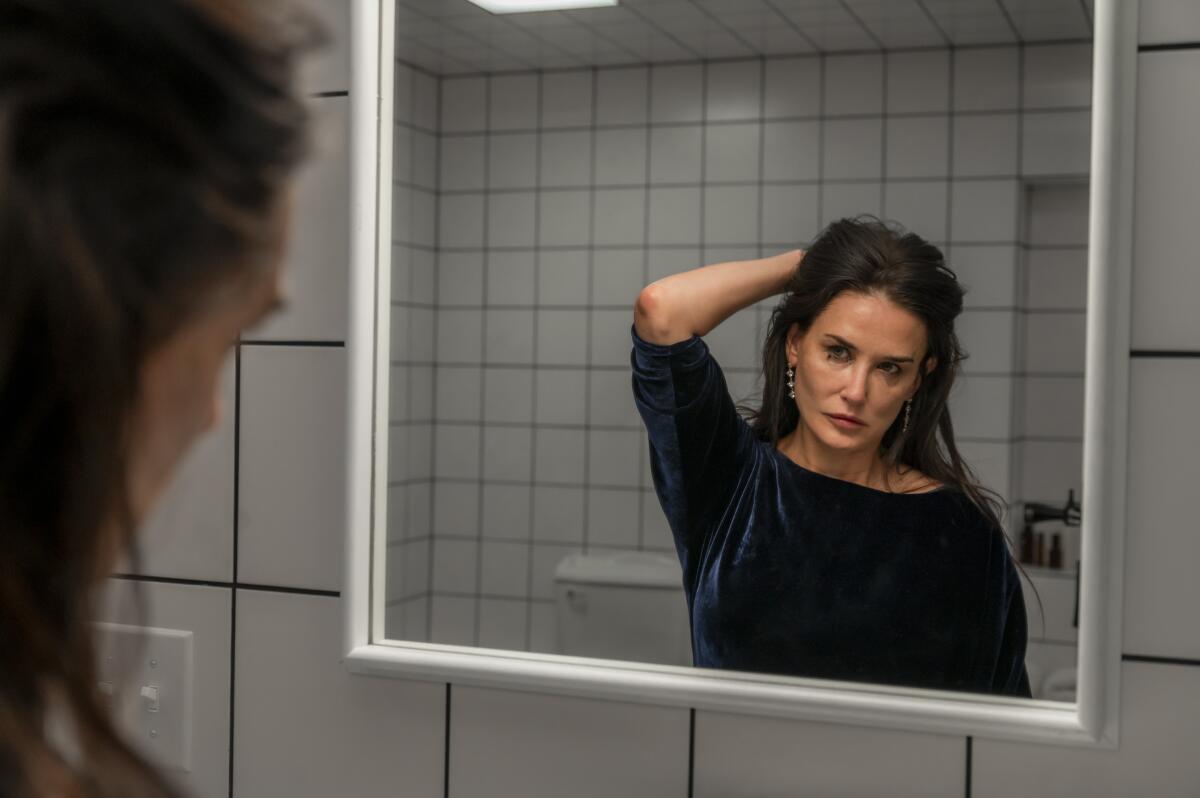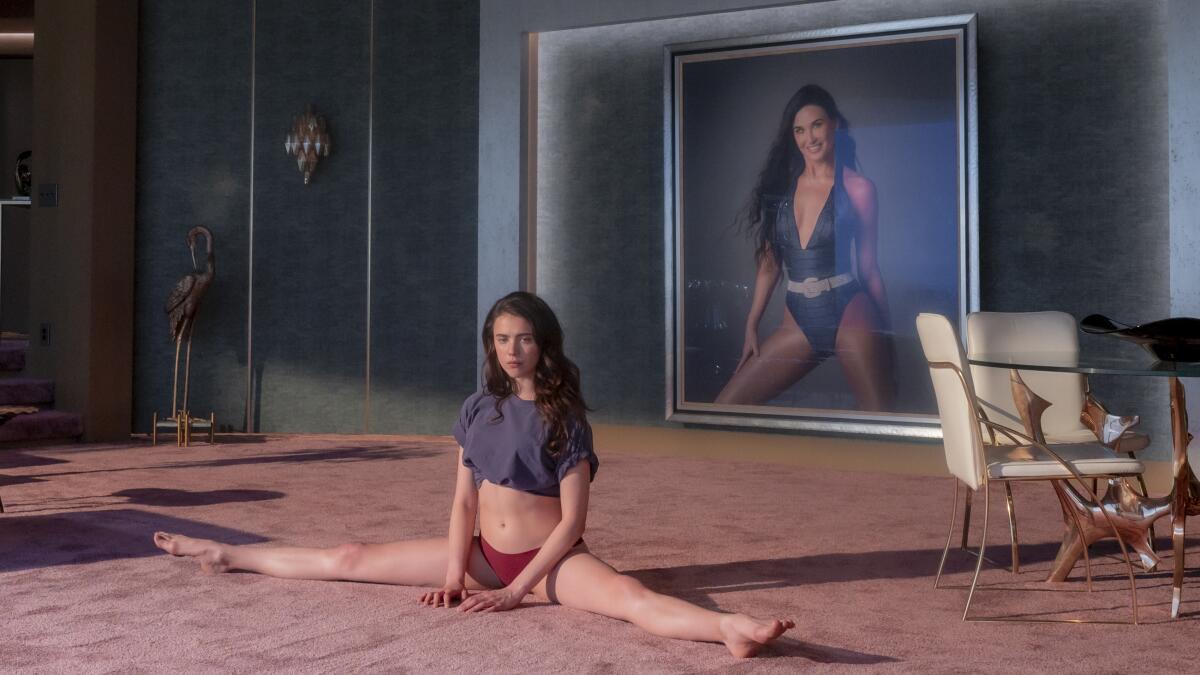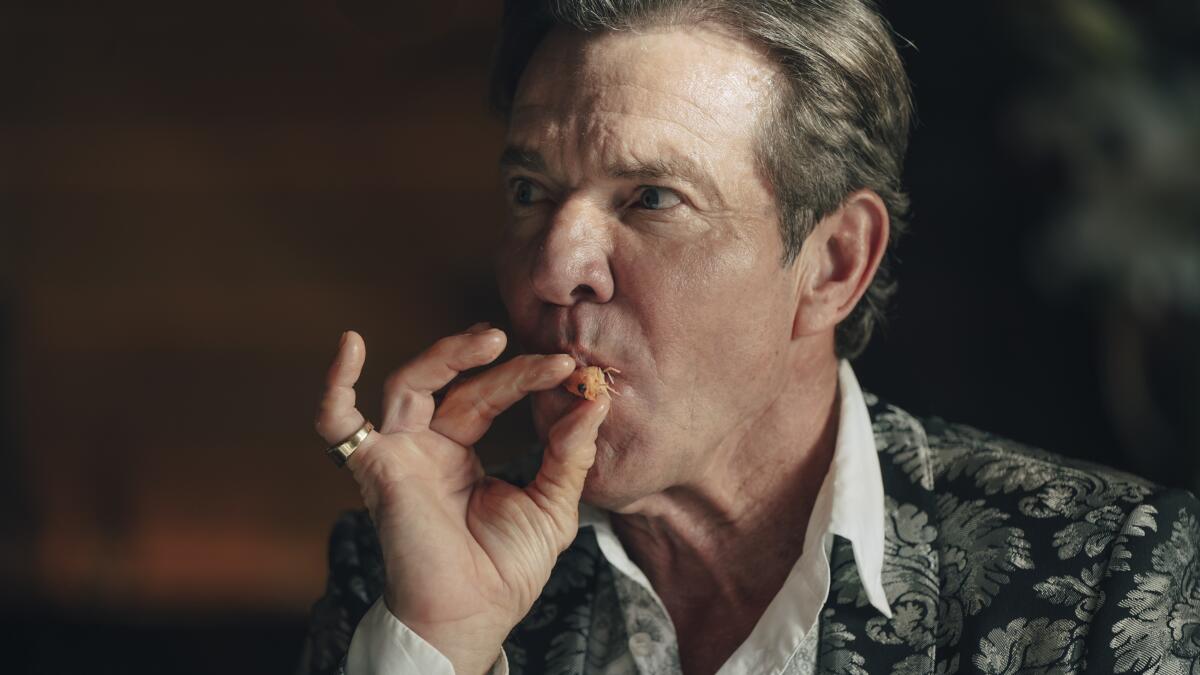Review: A Hollywood star wants more time, but ‘The Substance’ doesn’t give her a reason

- Share via
Filmmaker Coralie Fargeat is fascinated by butts. “The Substance,” her Cannes-winning gross-out joke about an aging Hollywood actress with a high threshold for self-inflicted pain, boasts more butts per minute than a chainsmoker’s ashtray, a feat all the more monumental for the film’s nearly 2½-hour running time. Be they spandex-wedgied or jiggling nude, each is caressed by the lens with the same hunger a burger commercial has for its buns. Point made: In this body-horror flick, a human’s only worth is as meat. With fearless, ferocious leads Demi Moore and Margaret Qualley willing to let the camera chop them into chunks of flesh — lips, calves, hair, wrinkles and, yes, keisters — for a film that prioritizes shocks over plot, get ready for a whole lot of their blood and guts too.
The story is simple. Former star Elisabeth Sparkle (Moore) is too old to continue hosting televised aerobics, the last stop on her slide out of the industry. Once, Elisabeth had talent. She even won an Academy Award if you believe the mutterings of her boss, Harvey (Dennis Quaid), who, in the spirit of the film, grumbles, “Oscar winner, my ass.” But that was so long ago even Elisabeth’s forgotten she’s more than a set of toned thighs.
A darkly surreal fantasia about Hollywood misogyny, “The Substance” delivers some of the year’s most fearless acting, along with a bold new directorial voice.
Elisabeth’s solution is a solution — a green goo called the Substance — that cleaves her cells in two and grows a second, youthful her who climbs out of her back and takes over her existence. When her alternate, Sue (Qualley), sashays into Elisabeth’s old TV station, a palpitating Harvey instantly anoints her his new exercise goddess. Cue butt montage! The editing is high-energy, entertaining and hammering; if every scene’s hip thrust or needle stab was shown only once, the movie would be 90 minutes long.
“The Substance” has two catches. First, the women must alternate weeks, giving Sue only seven days to twerk before ceding her consciousness back to Elisabeth, who then must trust herself — and her other self — to continue trading the baton, or else. The more tragic catch is that, under the skin, Elisabeth/Sue hasn’t changed at all. She still has the same shallow ambitions, the same ugly self-loathing that lets her leave her comatose older body lying on the bathroom floor like a dirty towel. Watching Qualley strut about in a pink bomber jacket with matching lip gloss, it’s as though Barbie became human but refused to evolve.

Every man in the film is repellent, even the hunks, and as the film goes on, they metastasize into an anonymous graying horde. But Fargeat is a messy feminist — a Carrie-on-a-killing-spree-at-the-prom feminist — who, rightly and excruciatingly, insists that her heroine is her own worst enemy. Sue even continues to smile obediently for the same jerks who kicked Elisabeth to the curb. Her back got sliced open but there’s no glimpse of a spine.
I’m unconvinced there’s that much going on inside the movie, either. It’s a superficial film about a superficial world and, like its protagonist, it’s got no pretensions of anything more. Fargeat has flair, and she’s clearly earned an unofficial PhD in MTV and ’80s VHS, particularly the gory stuff that makes you gasp and giggle. She and her cinematographer, Benjamin Kracun, love bold grids, bright colors, extreme closeups and distorting fish-eye lenses. Her style is as subtle as a stop sign (she even named Quaid’s vile producer Harvey) and her storytelling so visual that her storyboards could be a comic book. (The wordless opening sequence on Hollywood’s Walk of Fame that captures Elisabeth’s rise and fall is fantastic.) If this were a graphic novel, all we’d miss is the ghastly effective soundscape of squelches and pops, although that would make it easier to endure a shot of Quaid gnashing shrimp into his maw, or when he strides up to the screen like it’s a urinal and appears to pee in our laps.

I can’t think of another Cannes screenplay winner that seems as indifferent to its own script. A native French speaker, Fargeat’s stripped the dialogue down to what feels like 10 pages, and much of that gets recycled in flashbacks. At heart, Fargeat is a remix artist who’s constructed the movie like a medley of her own DVDs of “The Fly” and “Sunset Blvd.” and sleazy music videos from the early aughts. She flaunts her influences like a plastic surgery client who requests Angelina’s lips and Charlize’s nose. In one scene, I thought to myself that a special-effects creature in the film looked like Gollum…. — and then the end credits actually described it as Gollum. Still, by the time Fargeat cues up “Thus Spoke Zarathustra” (a piece of music that doesn’t need to be in a movie for another 2001 years) we’re restless to hear her own voice.
The film keeps its focus tightly on Elisabeth and Sue as they become each other’s roommates from hell. It’s got zero interest in who made the Substance or how many other people are taking it, or what its manufacturers are getting out of people upending their lives. To its own disservice, it doesn’t really care about Elisabeth, either. The character has no friends, no layers, no hobbies or interests other than being the hottest woman in the room. When her younger self goes on a talk show, her inanities get the kind of rapturous applause that means her fans don’t care what she says. If it weren’t for Moore and Qualley hurling themselves into the shared role, it’d be as flat as a scotch-taped pin-up. If it weren’t for Moore, I’m not even sure it would work.
Moore lived through the Hollywood that Fargeat is satirizing, and in her 40-something years in the business, she’s probably been asked more about her workout routine than her craft. Her conviction gives the movie credibility. No one would allow themselves to be lit that harshly if they didn’t believe in the cause. In return, she’s received a big, bleak, brave, funny, showy role that demands an entire career reappraisal, plus the flattery of, at age 61, convincingly playing 50. No matter how much the film insists she’s a hag, we know — and Moore knows we know — that she could do more squats than any of us in the audience. (And if she’s not happy with her looks, we’re all screwed.) As for Qualley, the fact that this is merely the latest audacious challenge in her filmography is the closest thing “The Substance” offers to optimism. Her body of work — far more than her body itself — proves that an actress’ lot can improve.
'The Substance'
Rating: R, for strong bloody violent content, gore, graphic nudity and language
Running time: 2 hours, 20 minutes
Playing: In wide release Friday, Sept. 20
More to Read
Only good movies
Get the Indie Focus newsletter, Mark Olsen's weekly guide to the world of cinema.
You may occasionally receive promotional content from the Los Angeles Times.











